The Real Market with Chris Rising – Ep. 83 Kevin Shtofman
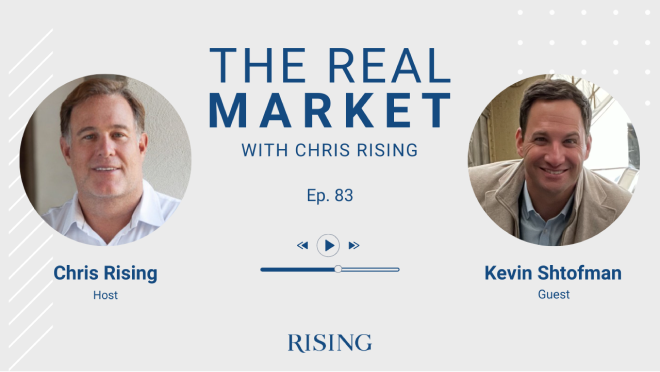
Chris Rising (00:02):
Welcome to The Real Market with Chris Rising, the only podcast that brings the real estate conference panel to your headphones, you’ll hear from superstars from every realm of commercial real estate, the biggest brokers, the most well-known architects, the largest investors, and the most visionary developers. We’ll learn what they do, how they do it, and what drives their success. We’ll discuss the latest trends across regional markets, capital flows both national and global, and we’ll explore technology’s role in shaping all of them. We’ll take a clear-eyed look at where we’ve been, where we are now, and what’s to come. Real conversations, real experts, real insights. This is The Real Market.
(00:50):
Welcome to The Real Market with Chris Rising. I’m really pleased to have Kevin Shtofman here with me. He’s the global head of innovation for Cherre. Cherre is a very interesting company as it relates to data collection. This has been a big topic. I’ve had a few people over the last year on the podcast talking about different things in PropTech, but where Kevin, I haven’t really jumped in is on this data collection and how we interpret data. And there was a recent article, I think it was in Business Insider, maybe it was Fortune Magazine, about how Blackstone has taken something they had in-house for their real estate as it related to data and parsing through data, and now they’ve done it throughout their private equity. So this is kind of a hot topic for anybody who’s thinking about a world in real estate without Excel spreadsheets. So Kevin, welcome to The Real Market.
Kevin Shtofman (01:39):
Yeah, thanks for having me. I’ve been listening to the podcast for a couple years. Super excited to be on, and I got to say, you’ve had a bunch of great guests on, but I don’t know, maybe it’s his age or pace of delivery. I could listen to John Cushman talk all day.
Chris Rising (01:56):
I appreciate that. That was a special three parts, and I will give John a lot of credit. I remember when I joined him early on, he was all about technology for what the real estate business was in the ’90s, and he started his own research department before CNW had them at Kushman Realty, and I still remember that when Steve Jobs took over Apple and they started producing the first laptops, John was gung ho that we had to get Apple laptops because that was the best, that was the innovation. So I appreciate that you liked that podcast. But here we are in 2022 about to go on to 2023, and what I’m excited to have you on the podcast about, Kevin, is this is a different world we’re in.
(02:40):
I mean, it was easy to say that in 2021 because we were still dealing with head-on winds from the pandemic, but here we go into 2023, finishing 2022, we don’t have the emphasis on the pandemic, but what we do have is a big emphasis on technology and PropTech. And it’s one thing to have PropTech that tells you what the temperature of your building is, it’s another thing to have PropTech that allows you to order a sandwich up to your space, but your PropTech, the things that you do, are what drives a business. So why don’t I give you the platform a little bit here just to tell us about Cherre. Tell us about the technology and why anybody who’s in real estate really should be listening to what you have to say.
Kevin Shtofman (03:22):
Yeah, of course. So Cherre started in 2016 with the intended use case of being a single endpoint for all commercial real estate data regardless of where it’s at, where it came from, public, private; paid, free; internal, external. The idea was and now is, because we’ve had a lot of great clients justify it for us, that if you have access to all information about the business such that you don’t need to learn 15 different tools run the business, you can accelerate decision-making when it becomes material to the business, so where to buy land, what materials used to construct the building, what GCs to engage, what type of tenants you should try to attract in your building, what amenities you should put in the building, what type of human capital you should hire, what you should do to maximize retention of your tenant mix, of your employee mix, et cetera, and how those decisions will change based on market dynamics and the data that you’re looking at backward and as you forecast forward.
Chris Rising (04:29):
So I hear everything you just said and then I can just kind of sense a collective groan from every CFO out there that, “Wait. Does that mean I need to now buy out every one of those verticals you just mentioned that I have a software for, whether it’s VTS, whether it’s Yardi, whether it’s Dealpath. In order to use Cherre’s software, does that mean that we have to abandon everything else, or how does it work?
Kevin Shtofman (04:56):
Quite the opposite. So the goal of Cherre… Maybe a bit about my career before I arrived at Cherre. I spent about 18 years in commercial real estate, but nine of those years I was in management consulting, and our job was to tell owners, operators, investors, managers, advisors what to do with their tech stack, and the problem we kept running into was if we told somebody to make a big change in their organization, it wasn’t the tech that was the problem, it was the people. They had great processes that were working. They probably weren’t working perfectly, but they were good enough to where as long as you had dry powder and you were making investments and you’re doing your work, the returns were there, investors were happy. You didn’t want to blow up your business model, you didn’t want to change how you’re doing your job every day. So Cherre has been built to engage actively with all of those tools so that your day-to-day process actually doesn’t change very much all, but how you experience the information from those tools is much more holistic, much more consistent and much more secure.
Chris Rising (06:01):
Interesting. How do you get over the hurdle of just why am I paying for one more thing? That’s something that I hear a lot. We’ve had all different kind of software people come in and try to pitch us on, and that’s kind of the threshold question that the CFO’s going to ask is why would I pay for something that’s producing out of software I already paid for?
Kevin Shtofman (06:26):
So there’s two answers. One is what do I say to the CIO, information not investment and the requisite IT team that’s involved, because they’re worried about something much different than everyone else in the business. Their worry is, “All right, you’re adding another layer. How is this data going to be shared securely? How are the right people going to have access to the right information without seeing things they shouldn’t? How are we going to be able to share this information externally to the right parties without risking anything proprietary?” It’s all about security access, performance, all of those things, and Cherre is fantastic at that. It has a great track record for multi-years with trillions of dollars of assets in the platform.
(07:11):
But how I address it with the business is time saved in work and accelerated decisions that are material to the company. So if you and Scott and Mimi, and I’m trying to think who else might make up your executive committee without knowing too much about the company. In having a one-hour meeting to decide on a potential acquisition, if you have the right data visualized in the right way such that you can make five big decisions in a single hour meeting versus one decision in a single hour meeting, that is material to the enterprise value of a company because now you can get through a much larger deal volume, you can avoid hopefully the risk of bidding on the wrong deals when it comes to large leases, you can identify tenant credit risk, but there’s just so many things that there’s material value to avoid signing a contract or more quickly engage and sign a contract before your competitors do, and this, depending on the size of the organization, could be hundreds of thousands, millions, tens of millions, maybe even billions of dollars.
Chris Rising (08:26):
So let’s kind of break it down a little bit more though and look at the product overall. What am I getting? If I were to say, “Look, I’m not sure what I need. I know I use VTS for my leasing, I know I use Dealpath for our acquisitions. I know I’ve got Yardi, and well, I know we used Juniper Square.” What is it that Cherre would be able to do for us as an executive team with those kind of underlying, or put their competitors in there, underlying software that we use on a daily basis? Not to mention our project management, which is Asana. I mean, how does this all fit so that it’s a simple step for an executive team to be able to engage with it?
Kevin Shtofman (09:09):
Yeah, so the good news is every tool you mentioned, we have active integrations with, we’ve done it for multiple clients. So sometimes that’s via an API, sometimes that’s scheduled reports, sometimes that’s ETL. It’s people that are much smarter than me technically handle, but once the information is all being fed into the Cherre platform, you can engage a user experience that allows you to have access to all the information relevant to each party. So what’s an example of someone in your company? Maybe Casey Hursh that’s overseeing investor relations. He’s likely going to have a lot of knowledge about Juniper Square because that’s tracking all the potential investments from your retail investing platform, but it’s probably not going to know as much about the current lease pipeline that’s in VTS, or he might not full grand vision of all the bids you’re considering on deals within Dealpath.
(10:02):
But he doesn’t need to learn those tools because all of that information is now being integrated together into a set of dashboards that can tell him, “Okay, if you’re going to meet with so-and-so potential LP and you know their mandate is to invest in class A office and go counter to what the market is today, okay, here are the existing rent roles of our current office assets, here are the bids we’re looking at that our competitors might not necessarily know about of office buildings that we’re looking to maybe repurpose or upgrade,” and that information is now shared with him so he can go sell to an investor without ever having learned any of those other tools. Without having to change his process, now he has that data.
(10:47):
The opposite thing could happen with Kayce Hawk, right? She’s overseeing property management, so she’s going to know everything about currently operating assets and the work order problems that are happening there, but she might not understand all of the relevant ESG data, or maybe all the parcel data you’re looking at, but have it all available to her, she can say, “Oh, okay. We have this plot of land coming up that we might buy that is three blocks away from one of our current assets of what maybe, just maybe, the assets are close enough to where I could use the same team to service both buildings so I don’t have to double staff.” So those types of decisions they can do with access to the underlying information in the Cherre platform.
Chris Rising (11:32):
That’s pretty interesting. Now, how do you deal with the fact that some people… One of the things that I’ve seen coming out of the pandemic in this hybrid work is people really do work differently as it relates to technology. Some people are like, “Give me a PC and the Microsoft platform and I’m happy as can be.” There’s other people, especially I think if you’re more on the exec level, which is really, “I want to do everything from my iPhone, maybe an iPad if I want a bigger screen, but I really don’t need to open a clamshell and start pecking away at an Excel spreadsheet,” to then there’s literally property managers who have to be so focused on a screen that has Yardi on it. How do you meet the needs of all these people? Do they have multiple options? Can you use it mobilely, or how do you meet those needs?
Kevin Shtofman (12:25):
With a lot of scar tissue, a lot of money spent, a lot of lessons learned to get it to the point where it’s interoperable with pretty much every operating system and every device. So your experience on a Lenovo laptop versus Microsoft desktop versus a Apple iPad versus a Samsung mobile phone, you’re seeing the same information and it’s not a completely identical UI because once you take the screen down to the mobile phone level, you’re going to be doing more scrolling, but you have access to the same data, you have the same security, you have the same visualizations.
(13:05):
We try to make it completely device and platform agnostic so that it doesn’t matter whether you’re sitting here in an office talking to me, or you’re at a lunch with a construction partner, or a client, or a data partner and something really, really important comes through an information, okay, you can have that available on your phone. That matters a lot, especially as we begin to live more mobile lives and we’re gathering intel while on the move. You need to be able to record that information in a way that it doesn’t completely interrupt your flow or your momentum.
Chris Rising (13:41):
Wow. The problem, Kevin, I’m having with this discussion is I think you and I can get down into some real weeds and really talk. So I wanted just take a little time out and say how does a guy who has this much knowledge of technology, but also have a real strong understanding of real estate, how did you find your path to where you are right now?
Kevin Shtofman (14:05):
It was not a straightforward path. I started my career in financial services. I was at Morgan Stanley at the end of 2007 when the market was absolutely bonkers, and I remember going to my boss saying, “How do I make VP?” And he said, “Well, you can get your CFA, or you can get your MBA, or you can bring us a billion dollars worth of deals.” I said, “Well, MBA sounds the easiest, so I’ll just go do that.” Little did I know that week two of grad school would be the Lehman crash, so everything I was thinking about in terms of having this wonderful high-flying transactions career in real estate was not going to be available when I graduated in May 2010.
(14:45):
So I went to Ernst and Young and joined what is now their real estate technology group. I think it was called Performance Improvement at the time. I thought I was going to do it for a year. I thought, “We’ll let the market recover, we’ll let people raise more dry capital and I’ll find a job deploying it,” But no, I nine years later was overseeing PropTech for the US for Deloitte and my job there was to evaluate companies like Cherre. There’s such a proliferation of them in 2019. In 2017, it was like this new fancy thing and I was going up to conferences and podcasts and saying things like machine learning and AI, blockchain, and people looked at me like I had three heads, but then by 2019 you just had all these different companies and I was spending time with many of them, and I found a startup that I fell in love with, it’s called Navigator CRE, and they were focusing on the visualization portion of commercial real estate, and it was just a really, really great looking tool and I knew clients needed it.
(15:56):
So I joined them as their COO and spent a number of years there and I got the startup bug. We grew from 10 employees to 50, brought on a bunch of clients, we expanded into London and I knew I couldn’t go back. Once you become an entrepreneur, I feel like it’s the only job you’re willing to work 80 hours a week so that you don’t have to work 40 hours a week, and just that happens. And over the years while I was there, I spent a lot of time, especially at conference shows with the Cherre team. They always seemed to have a booth near ours and we interacted together. We even ended up partnering together on a large client, Starwood Capital, and just really, really fell in love with the team and the time and circumstances worked out recently so that I could join their growing company.
Chris Rising (16:49):
Terrific. Well, I know you’re a Longhorn, you got your MBA from SMU. Are you still based in Dallas with this?
Kevin Shtofman (16:57):
I am. Obviously I’ll be in New York quite a bit, but my purview is international, so I’ll be on the road quite a lot, and luckily my wife is super patient. We’re expecting girl number three I think in June, so managing a growing family and a growing business.
Chris Rising (17:19):
Well, that’s terrific. I mean, I know from my experience with three kids and travel and all that, that managing time is really, really difficult and also managing your time around your sales and your screen and your family. So let me ask you just as you’ve made this change… And actually I would just go back even to going from a big company to the startup to now a somewhat bigger company, what’s your take on the real estate industry’s willingness to move forward with this kind of technology because we have a reputation in this business of being way behind. You’ve now seen it from three different views, consultant, smaller startup to a bigger startup. What do you see happening out there in terms of your sales process, are people convinced, or there are a lot of skeptics out there?
Kevin Shtofman (18:10):
Yeah, the good news today is, I don’t want to record the exact numbers here so I’m putting an asterisk on this, but I think there’s around between four and 5 trillion dollars worth of assets flowing through the Cherre platform internationally. So clearly we’ve found a lot of very large institutions that are impressed by the platform that have been using it for a while, and I don’t know which client names I’m allowed to mention since I’m pretty new to the company, so I’m just going to say there are a lot of them and we publish a bunch of those logos on our website. But clearly the use case is there, people are excited about it. But it’s like any other industry, you have some folks who are early adopters and they understand that having all the data in one place is just going to be the way forward, and so they’re willing to do it now, you’ll have some that have to be just drug kicking and screaming, and then there’s the largest group that’s in the middle that typically waits for the companies that they respect to choose a winner, to choose the platform.
(19:15):
I think luckily we’ve now gotten to the point where we have some of the largest, most respected names in real estate on the platform. So now it’s a lot of those middle market, like 500 million to 2 billion operators, and there’s so many of them out there. They’re geographically diverse, they’re property type diverse, they’re lifecycle stage diverse, so there’s a lot of ways the platform can help them, but you really have to have honed offerings that’s going to speak to them because technology budgets are limited. They’re going to be even more limited in 2023. Even if deal activity slows down because it’s harder to get financing because interest rates are higher, that doesn’t mean that with the money that’s now available, they’re just going to go spend it all in technology. Everything is going to have more of a microscope than it did before.
(20:06):
I’m sure you’ve experienced this at Rising it, I think you started about a decade ago. My guess is the market’s been pretty kind to most of your deals and that’s because you have a really smart team, but just because money was fairly inexpensive and the public markets were also reacting positively, and so life wasn’t easy but it was easier. Now we’re entering into probably for the first time in a decade a period of pretty high market uncertainty, and so everything’s getting evaluated more than it likely would’ve a year ago.
Chris Rising (20:41):
Well, I couldn’t agree with you more. I think one of the biggest analysis when it comes to employees, and I think one of the things that you’re looking at as a honorable business is am I better off spending 50 grand that gets us a software that we can all use, or is that 50 grand better spent on a salary? When you’re looking at the option on Cherre about someone spending that kind of money, what can you really say about the need for more employee use, more employee training, or can you really save on your headcount using this type of software?
Kevin Shtofman (21:21):
Yeah, Cherre is definitely designed for institutions that, despite market uncertainty, you want to continue to grow. If you grow, grow your asset base, grow your footprint, grow your project volume, et cetera. If you are a family office that has the same pool of capital, it’s not going to change, you’re just operating businesses you don’t ever really sell. Cherre will absolutely be helpful, but it’s going to be harder for the economics to work for that deal to pencil, but for any organization that anticipates that 24 months from now, you’re larger, you’re more complex, that’s when Cherre makes sense because depending on the size of the organization, we end up being the equivalent cost of a single FTE at a either small or mid-size organization and then maybe a handful of FTEs at a large organization, like 20 billion and up.
(22:14):
And the economics are no-brainer. What we’re often competing with isn’t status quo versus use Cherre. It’s we’ve already decided we need an answer to data, but do we want to use the Cherre platform or do we want to invest significantly in our own people and try to build the thing ourselves? That’s typically the competition we run into, because there’s this thing about control and who has control over workflow and access and data, and that’s why we’ve purposely tried to become Switzerland because we want to say, “Look, client. Your data is your data. We don’t make money off it.”
Chris Rising (22:52):
I think that’s a great point. I think if I’ve learned anything in my 25 years in business is that every time I made a decision around software that was to fit specific needs that we had, that was a huge mistake because those would change and there’s just always is a better mousetrap that comes along, and so since we started this company 10 years ago, we’ve tried to really be off the shelf, stuff that you couldn’t use off the shelf, not have a five year amortization schedule because you tailor Salesforce to exactly what you thought you needed. So I think that’s an important thing.
(23:27):
Now, I think the offset of that or the other side of that is it has to be a very friendly user interface because to get someone to say, “Okay, I’m going to give up everything else I’m doing, I’m going to use this UI.” So what is it about Cherre you think that makes it simple? Will someone like Casey Hursh, who spends most of his time in Juniper Square, is he still going to be in Juniper Square and then just use a dashboard, or what’s the UI?
Kevin Shtofman (23:56):
Yeah. In essence, most of the day-to-day activities that anyone is responsible for, they will remain in that source system. So whatever John Golden or Scott Hahn or Scott Ho are using, they’re going to stick directly into the Yardi or Juniper Square or VTS, but when they want to come together and collaborate across departments and share information, all of that would happen in Cherre.
(24:23):
Without showing you the platform, I would tell you that about 90% of what you experience in the platform is just something that came directly from our clients. Our clients said, “Look, we’re in the real estate business. We’re not a technology business. This is what we want. Solve it for us, figure it out,” and it’s great because these are very large institutions that have a lot of experience and a lot of sophistication that know what they want but don’t want to spend the time building it or testing it, or to you said, trying to build to something where the puck is not where the puck might be, and so we’re always gathering and crowdsourcing all that feedback to build functionality for where we know the puck is going to need to be in six, 12 or 18 months.
Chris Rising (25:08):
Well, let’s talk a little bit about where the puck may be today. You’ve just gone through a job change and I think we talked about before, you were working in WeWork and there’s been a lot of pundits out there initially saying that remote work was going to be here forever and that’s what it was going to go, and then obviously people have jumped on the Elon Musk Twitter stuff, but no, you need to be back to the office and we hear that from staff and we hear it from a few others, but you’re out there in real-time traveling the country, traveling the globe, selling a software that makes people mobile. What do you think the future of office and office use is going to be?
Kevin Shtofman (25:44):
I think it’s going to be very driven by personality. So regardless of seniority level in the company, regardless of department, maybe not regardless, there’s going to be some alignment by personality type, but I think you’ll find that companies will be more flexible with who they want to come into the office and everybody who’s extroverted, who needs that social experience, that collaboration, that activity that we know drives innovation, they will be in the office at least three days a week, and we’re seeing that already. Most people, if they have the opportunity to come in, they will come in, and if their commute is so far because of where they’ve moved, they still need just that feeling, that vibe of being around people, they will end up in a co-working space near their home.
(26:26):
So they can leave the home and be in an environment, even if they’re not talking directly to all these people that are here, just having other human beings around and not being subject to a dog barking during an Amazon delivery or a child coming home or leaving for school, and you’re having to manage that while you’re trying to work. That’s all out. But to the introverts, if they want to stay home, if they actually thrive on a more quiet, lower sensory environment where they can do concentrated work and then once a month or couple times a quarter engage in team building activities, then that’s what they will do, and I think most companies will adhere that flexibility to the style that people want, which I think for the most part will work.
(27:10):
Where that creates risk is in climbing up the ladder, being promoted, taking on new responsibilities. As the head of innovation and building my team, if I’m going to bring someone up from a senior associate to a director or managing director, obviously just the first thing that’s going to come into my mind is, “Who have I been interacting with and building a relationship face-to-face?” They’re the first people that are going to pop into my head, and if they’re not popping into my head, their work product has to be so much better than the other person’s to make me think of them first. So it will create probably an uneven playing field and younger employees are going to have to choose do you value being home and alone and willing to work that much harder to prove your value versus being okay with going into an environment where you need to dress the part and socially interact and do those things even if you don’t like.
Chris Rising (28:07):
Yeah, it’ll be interesting. I read something this morning that kind of blew my mind a bit, but in 2024 there’ll be more voters who are in Gen Z and millennials than there are in Gen X and baby boomer, and so when I listen to a lot of my baby boomer friends who are older, I’m Gen X, and they talk about, “No, the only way you learn is if you’re in the office,” and I’m like, “Well, I don’t know if that’s the only way. That’s how I learned, and it was great. I mean, I really loved my life before I got married, and my business life and how I could travel and I could do all those things, but it’s not the only way.” So it’ll be very interesting.
(28:47):
I don’t know how we’re in a much different place when it comes to introverted people when we were in the office and then now more online. I think personality does matter in terms of leadership and things like that. So if one isn’t a leader, it’s hard to move up and I think it’s hard to be a leader behind the screen 24/7 the whole time. I think you got to get out, you got to be around people, but I do believe… Yeah.
Kevin Shtofman (29:12):
I tried to work from home. I did. I tried my best. I was like, “I’m going to try this work from home thing, no more commutes, this is so convenient,” and there were multiple times a day that just kids and dogs and background noise and internet going out. I got so frustrated and those rare times when my wife was home, she would be like, “Can you please just leave the house? You’re not pleasant to be around when you’re like this, just go to an office and have your time.” Come home and be present.
Chris Rising (29:47):
I think you hit on some really important things there, and I think at the end of the day, we like being part of teams. Even if you’re more of a golfer or tennis player, you have your team, your coaches, and we all like that and I think… I’ve never seen a sitcom about one person living in their house by themselves. I mean, they happen in a coffee shop or a bar. Those are the human interactions, so I think that’s really important, but I think the reality is though we are continuing, I mean, to see AI have an impression in our lives. We got the ChatGPT that’s come out and just in one month has revolutionized how people think about AI. We were looking at something on Dyopath the other day and the way it’s scraping information out of OMs. That was a job. That was a job that somebody young had to do was get all that information out. So we’re seeing this impact. Can you give us a little idea about what Cherre is seeing when you look into the future about the role AI is going to play?
Kevin Shtofman (30:49):
Yeah, we’re really, really excited about AI, not because what it delivers today, which we think is pretty rudimentary, to be honest. Even ChatGPT, which I’m super excited about. Grew from zero to a million users in five days. Just astronomical growth. What we think AI will do in the medium-term is just become a force multiplier for younger employees. So all the things that were really, really manual and annoying to do, especially when you had to do it multiple times in the same month, those were the types of activities that threaten retention, that threaten company loyalty because you’re doing repetitive things that you don’t find exciting and it lowers the amount of time you could spend with executives, like talking and thinking strategically. So I think AI will begin to replace building tables, building narratives, conducting the same types of automated calculations.
(31:50):
So you’ll see basic financial models, you’ll see some marketing circulars, all these things. The base level of that document will be built by AI and then a human will go in and do the last 20% that’s going to make it completely relevant and important to what matters. If you completely rely on AI, it’s not going to be sufficient, but a lot of those really annoying competitive activities, it’ll look more like ML at first because you’re feeding at the data and telling it the rules it should be following, and then eventually AI helps it learn. I’m really excited about it. I think it’s still going to be a few years before you see anything that’s actually meaningful, but the great news about AI is that the problems that we’ll solve first are the most boring, annoying, loyalty-threatening activities in your business.
Chris Rising (32:45):
Yeah. I mean, I do think that’s… Going to make an analogy back to hybrid work, I think that’s one of the things that hybrid work has done is killed the commute. One of the most boring, awful times that you spend are the hour and a half commuting each way or whatever, and that killed it, and I think that’s why most people are gotten somewhat rid of business hours, you work when it’s more convenient and all, and I think AI is going to help on the exact same kind of thing. There’s all these little bumps along the road.
(33:15):
Now, I go back to my question though earlier that we were just kicking around, which is what happens if you’re a young person and some of these things that taught you the business is being done by an AI. How do you think young people are going to get involved in the real estate business if they’re not walking buildings anymore because they don’t need to, or they’re not scraping through Argus 15 times to find where a brokers put something in, hidden something in because AI will find it? How do you think young people are going to learn in a more AI-dominated world?
Kevin Shtofman (33:47):
They’ll be forced to because even if they think they’re getting extra value from AI, so will everyone else be, you’re just going to lift the baseline so no one’s doing those activities anymore and now they’re all competing at a new higher tide level of activity. So if you’re an analyst on the acquisitions team, all right, maybe all the parcel data’s already been pulled for you, maybe all of the owners that could be unmasked, and so who actually owns the LC is now unmasked. You’re just competing with someone who has access to the same set of information, so you need to adapt to that and continue to get smart, and likely that means building relationships with brokers, or appraisers, or assessors, or people who are not putting that data on a publicly available database. You’re still having to engage.
(34:39):
The real estate will always and forever be a relationship and people business no matter how many activities you infuse with AI, no matter how much data you collate, there is a relationship component that just cannot be replicated by technology, and I say that as a technology evangelist. It will still be relationships, and I guess the last thing I would say is for those that probably for a while hated the commute, learn to love the podcast, I’m not saying that just because I’m taping. So many things I found to be boring that became tolerable with the podcast, folding laundry, putting dishes away, getting on the subway and going to work. It was like all of a sudden I could now fill that time with something that was engaging and entertaining, and for young real estate people, there’s so many real estate podcasts out there. You can be building your skillset and learning the business while doing activities you formally found to be boring.
Chris Rising (35:44):
Yeah, I think all those are great points. I want to kind of go back around here. So you’re based in Dallas. Clearly Dallas and I would say more than even Houston and Austin, but Texas clearly approached the pandemic differently. You look at the castle systems, you’re seeing that consistently the Texas cities have a higher daily occupancy, but it’s not dramatically different anymore. Even in the Los Angeles or San Francisco, you’re seeing people now in the mid-40s hitting 50% of the time on a five-day week. So it tells me that people are coming in Monday… I mean, coming in Tuesday, Wednesday and maybe a half a day another day, but are there things about Texas that you think make it unique to the real estate industry right now? Is there anything about that you’re seeing from your company’s growth? Here in California, we’re seeing companies leave by the droves. The weather’s still better here, by the way, but we’re seeing people leave. What’s your take on the Texas story as it relates to real estate?
Kevin Shtofman (36:55):
Yeah, I think a lot of real estate companies are now thinking bigger, whereas they had some really, really amazing enterprising companies had narrow footprints that they were looking at. Now, at the availability of data, they’re now looking larger to more of a national footprint and to really get some of those deals done, you’ve got to be there. At least at the very end of the deal, you got to be face-to-face, and so a lot of companies that might be headquartered in New York, or LA, or Seattle, or Miami, you’re thinking, “Well, to get across the other side of the country, that’s tough. That’s tough from a time commitment, that’s tough from people commitment, access to talent.” Most of those folks also exist in high tax states, so you’re giving a larger percentage of your income back, and real estate really was almost created as this amazingly tax advantaged investment vehicle and still is highly tax advantaged.
(37:44):
So for those reasons and many others, Texas has become such an attractive market because you have more business-friendly climate, you have no state income tax first of all, you have an infrastructure either at DFW Airport or Intercontinental Bush and Houston, even Austin Bergstrom, where you can get to pretty much anywhere in the country same day. So getting to the markets you’re doing business with comes a lot easier. One of the things that Texas I think kind of lacks compared to the other cities we’ve mentioned is public transportation, which probably hasn’t been as big of a deal during COVID because people weren’t using it, they all bought cars, but I think you’re going to see more people now coalesce back to, “Well, how can I access the venues that attract people?” That’s actually one of the reasons I was so impressed with SoFi Stadium when I visited for the first time. I’m pretty biased, Jerry World’s pretty cool. It was kind of the first of its kind when Jerry built it, but being out at SoFi, I mean, that took it to a whole new level and how you think about live work and play.
(38:55):
And that re-imagining of a real estate building is probably the next trend we’re going to see, especially in 2023. People are going to rethink how many different activities you can engage in what used to be just an office building, right? There could now be retail multifamily, there could be even dark logistics, there could be ghost kitchens. I mean, there’s so much that buildings are thinking about doing so that people stay captive and excited to either be in that building or come to that building.
Chris Rising (39:27):
Yeah, to that point, I think one of the things that we’re going to see over the next three or four years is a total basis reset on office. Some of it nothing to do with how a building was operated, just leases came due and people decided they needed less space, values came down, but that basis reset then allows you to repurpose. It’s pretty hard to buy an office building that’s well leased and repurpose it to multifamily because just the cost. If it’s an empty office building, you could repurpose it. But I agree with you, and I also think the idea that the home is the dominant way someone works remote, I think there’s just some jobs that always should have been and probably could be, but most jobs aren’t, and I’ve heard, “Oh, we have all our government people work from home.” Can you imagine a DMV that didn’t have many people working in it and everybody work from home?
(40:13):
I just think there’s a lot of jobs, the majority of jobs, and I think we get very elitist in our thinking about it because we’re really only talking about the most educated people on the remote work. I mean, if you’re a cop, you show up to work every day, if you’re a teacher, you show up to work every day, and one of the things that drives me nuts is people that got so angry about remote school saying how it wasn’t effective, but yet somehow remote work totally is. I just think there’s some jobs it should be. I mean, if you’re an engineer and you need to work asynchronous from everybody else, I think that works. I get it. I get it. If you’re trying to solve major engineering problems where you need a team, I get why Apple says you need to be in here and working.
(40:52):
But the one underlying thing, and I want to come back to this, is the fact that we need data, we need to use data better, and you have a product for real estate companies that is exceptional in its ability to extract data and make it meaningful. Why don’t we just take it back to the beginning? If I say, “Okay, look.” I tell my team, “I want to bring Cherre in because we need dashboards, I need to be able to see things, I want to be able to process information better,” what am I really telling my people about what a relationship with Cherre’s going to be like?
Kevin Shtofman (41:27):
Yeah, so we have a dedicated team of in-house I call them customer solutions experts. So these are people that use to work at real estate companies. So they were you. They felt your pain. Their job is to understand what systems you’re using today, what data is important to you, and then what would be nice to have. If you are in the leasing department, would having acquisitions data be helpful to you? Would having ESG data be helpful to you? Would having demographic data be helpful to you? So what helps you level up in your role and let’s make sure that you have access to that information and visualized in a way that can lead to prescriptive insights. So typically, we’re integrating and ingesting data from your core financial system first. Everything is going to be based off whatever accounting system you’re using, and then we’re bolting on other integrations from there.
(42:25):
Depending on the system you’re using, we can have the information integrated in weeks and you’re validating data and then you looking at the dashboards. But for a large enterprise with a bunch of different systems, it could be months, and some clients we’ve been working with for years that every so often they come to us and say, “Hey, we got this new data set. Now ESG is a big deal apparently. Our LPs are asking for it, so we need to bring out some ESG data. One, who should we use? You guys have a bunch of partners, who do you recommend? And once we pick it, how quickly can you integrate it?” So that conversation happens a bunch at Cherre.
(43:07):
And I think because each building has data relevant to different people and different parties, think about the owner of the building cares about some of the data, the operator of the building cares about some different data, the tenant in the building cares about some different data, the advisors to the building, the architect, the title agent, the broker, they care about different data, but it’s all based off of the same building ID that sits on the same parcel ID that ideally has the same owner LLC. So all of the data can then be modeled off of that core information, and then we run our machine learning algorithm to say when something’s coming in, it doesn’t match. So you’re not looking at bad data because it doesn’t matter how pretty the visual is. If the data’s crap, your decisions could be crap. So we avoid that problem up upfront.
Chris Rising (43:57):
But how pretty it is matters too. So do you get an app that works on the iPhone and then do you open a Chrome page if I’m on my laptop? How does this work?
Kevin Shtofman (44:08):
Yeah, we’re built on the G Suite. So you have a dedicated app and a variety of different modules and products that we offer, a searching interface, a mapping interface. So if you want to look at properties and parcels on a map, you have the mapping interface. We have a reporting output set, so you can run specific reports in the format that you’d like. We have a variety of dashboards that consolidate information or are visualized to whatever configuration you’d like. We have some off-the-shelf dashboards that are built in Looker, but what we’ve found is that some clients like Power BI, some clients like Tableau, some clients Domos, some clients like Looker, some clients want to actually do all of this themselves and they just want our secure data infrastructure and we allow them to do that. So we try to meet the client where they are, not where we-
Chris Rising (44:57):
And just knowing the real estate industry, I got to imagine most people don’t know, and so do you have an off-the-shelf of saying, “Hey, this is how most people start and this is what they like,” and what are the basic things in that you’re trying to aggregate for that owner?
Kevin Shtofman (45:14):
Yeah, we definitely have some standards that would say, “Okay, if you are a publicly traded office REIT and your core system is Yardi, okay, clearly you’re going to care about current rent roll, aged receivables collections and delinquencies, stacking plans, what you underwrote to when you bought the building versus what the actuals are now, how does that compare to what you’re forecasting in the future, what’s your ESG footprint?” There’s a lot of standard visuals we provide, but no client is the same. What we deliver is typically 80% good, and then where the real value comes is having our in-house real estate people get with the real estate experts on your side and agree what’s really going to move the needle for a company like Rising and how you would consider your competitors.
Chris Rising (46:03):
Do you do this as a subscription model per employee use? How do you price your-
Kevin Shtofman (46:12):
No, what we’ve learned at my previous company and at this current one, if you price per user, you disincentivize usage. If you price based on data consumption, you disincentivize the loading of data. So we needed to price in a way that would actually encourage everybody in the organization to use the platform because the power is in the network effect, the collaboration between the departments and geographies to actually make decisions together. So there’s a platform fee that’s based on AUM because the hope is that you pay a platform fee for a number of years as your AUM grows, the platform fee doesn’t necessarily grow, so you’re getting some enhanced value, and then every time you want to connect a new tool or data set, there’s a small increase to that subscription fee. So it’s really more about how many different systems do you want to connect together, that complexity creates your cost, but it’s unlimited users and unlimited data usage.
Chris Rising (47:12):
And how do you get to agree on what AUM is? Because that’s a pretty fungible number.
Kevin Shtofman (47:17):
Yes, it can be a loaded question with each client. Typically, and I’m a little early days in this, so I don’t know if I should speak with that much confidence, but we used to do it, my old company was if you have active assets that are bringing in revenue, they’re at least in lease up, that would be included in your AUM. If you had construction projects, we would discount that a little bit because that’s not yet providing you revenue and yet that data is going to be important to your business. Tracking budgets and change orders and estimated cost of completion and all those things that happen, you’re going to pay for that, but likely at a lower rate because you’re not yet bringing in revenue from those assets, but they could be included in your AUM.
Chris Rising (48:05):
But I bet it’s an active discussion at the initial stage.
Kevin Shtofman (48:09):
It is a very active discussion. My favorite is when I meet with folks who are developers, but were formerly brokers, their negotiating skills are very on point, and that very much requires face-to-face, often requires beverages as well.
Chris Rising (48:29):
I get it. I get it. Well, as we’re kind of getting near the end here, we talked a little bit about your family life and congratulations on being a father for the third time. We’ve talked about the way you work and live in Dallas. But tell me, I know you’ve got some other outside interests and things that you want. Give us a little flavor for some of the things that you do that keep you busy outside of work and family.
Kevin Shtofman (48:54):
Yeah, I’m a continually mediocre golfer. I have phases where I’m pretty darn good and then phases I’m not great. I injured my achilles back in March and so that’s been a journey coming back from that, but any time someone’s doing a charity golf tournament, I’m in. No matter where it is, I’ll be there. I in a previous life was an Ironman triathlete and did Ironman Texas, Ironman Miami. So I’ve always been a pretty active. The days of that distance are long over once you have kids. It’s like a three-legged stool. Be good in your career, be Ironman, be a good dad. Pick two. So that’s why. And then I’m in an active angel investment group. So we get a bunch of interesting PropTech companies and that has dual benefits. One, I get to invest directly in the companies I’m super excited about, but it also keeps me apprised of the actual market and where I think it’s going and who you should be partnering with as a company. And when I’m not doing any of those activities, pretty engaged with my girls. They’re at a pretty adorable age when they’re not having tantrums.
Chris Rising (50:14):
Well, the reason I really like to get to the full picture of all that you do is you’re involved in technology, I’m involved in real estate and technology as of you, but at some point this stuff can become dominating. So do you have any advice to people out there about how you maintain? Whether it’s going golfing and leaving the cell phone away, or how do you deal with the emergencies, whether it’s a wife calling saying someone’s sick versus a business deal you’re about to lose. How do you structure your use of technology in your day so that you can live a normal life?
Kevin Shtofman (50:48):
So I have a standing policy that I don’t work Saturdays. Unless the platform is burning down or there’s literally three alarm fire, I’m not looking at my email, I’m not looking at Slack. I’m not doing anything on a Saturday. There might be an interesting business development related event, but that means I’m out on the golf course, or I’m out on a boat, or I’m doing something fun and that’s not sitting in an office, engaging in business, and when I’m at those type of events, no device. I also create fake meetings in my calendar for time that-
Chris Rising (51:29):
Is that like a form of time blocking? I mean, whether it’s a fake meeting. You’re like, “Hey, this is the hour I’m going to spend to get this done.” Yeah, I found that to be the most important change I’ve made in my life is having a calendar that looks full, whether it’s fake meetings or whatever it is because if it doesn’t, it gets filled. If you have two hours, someone’s going to take those two hours and that thing you want it to get done, you can’t get done.
Kevin Shtofman (51:52):
100%. And most of it revolves around either dropping off or picking up the kids from school, or helping my wife as something around the house, or sometimes just catching up with a friend who I haven’t seen in a long time that wants to have lunch, and they’re not in real estate, they’re not in tech there, there’s not any way we’re going to be helping each other, but sometimes it’s just great to, for part of the day, turn that part of your brain off and engage in other things because then you come back extremely focused.
(52:30):
I haven’t run the numbers on this, but anecdotally, after about five hours of back-to-back meetings or direct work, I feel like my performance starts lagging a little bit unless I take a break. You just got to have breaks. And I’ve found that because of that, I definitely do more work in the evenings after the kids are asleep. I’m doing a lot more of that, but my day is much more flexible, and the great thing about this new company, Cherre, the team is very, very culture-focused. We have an all-hands meeting every Monday where all of the information is shared, deals we’ve won, deals we’ve lost, deals that have adjourned, things we’re thinking about on the product. And anybody’s allowed to ask a question, anybody’s allowed to provide feedback. The feedback can be submitted publicly or privately. I mean, it is the way-
Chris Rising (53:21):
And does it incorporate the sales and the engineers, or is it… Because a lot of companies keep the engineers to the side.
Kevin Shtofman (53:28):
No, all departments, all teams because really there is no part of the company that if you took them away, the company would still be thriving. If you didn’t have the sales team, we wouldn’t sell anything. If you didn’t have the customer solutions team, you wouldn’t keep any clients. If you didn’t have the engineering team, the product would never improve. So it might be great now, but six months from now, who knows. So everybody understands that we all need each other to create a scalable, hopefully billion dollar company.
Chris Rising (53:54):
That’s great. Well, I want to leave our discussion with I want to hand it over to you on this. So you know where Cherre is today and you have a good sense of where clients, what they want out of the product. What do you think will be different and better about the product over the next year or two that would encourage someone to make the commitment?
Kevin Shtofman (54:14):
Yeah, the forward-looking capabilities are going to be really interesting. Real estate has been such a backwards-looking industry for such a long time. How did we do these last three years? And for companies that have already figured that out, how are we doing today at present? What often is a struggle is, okay, trying to plan out what could happen in the future, doing a lot of scenario modeling and sensitivity analysis. That is coming. And the second thing is going to be more persona-focused visuals. Right now it’s you’re in the acquisitions team and you are overseeing office buildings, that’s interesting, but eventually it’s going to be, okay, I am a senior associate looking at this one deal. What’s going to be unique about that deal to me and how does that differ from the associate that’s two desks down? They’re working on a deal in D.C, I’m in LA, I have a 12-story building, they have an 18-story builder. You’ll start getting really, really granular with the way you experience the platform visually because that that’s where the real value’s going to be longer term.
Chris Rising (55:28):
Wow. Well, Kevin, this has been a great conversation. I appreciate you coming on. I wish you best of luck with the new baby and I can’t wait to hear more about Cherre. So thank you for being on the Real Market.
Kevin Shtofman (55:39):
Thanks for having me.
Chris Rising (55:41):
Awesome.
(55:42):
And please don’t forget to follow us. We’d really appreciate it. If you subscribe to the podcast, you can do that on Apple iTunes or any of the other podcasting services. It’s the Real Market with Chris Rising. And follow us on Twitter, @chrisrising or @risingrp, and please follow our blog, chrisrising.com or risingrp.com. Thanks so much.
Speaker 3 (56:06):
This episode of The Real Market is brought to you by Rising Investor Platform. The platform provides accredited investors with exclusive real estate investment opportunities on a deal-by-deal basis across various asset classes, including office, industrial, hospitality, multi-family, and data. The platform also provides an inside look at deals in our pipeline while giving investors the chance to indicate interest before it’s too late. We recently funded our acquisition of 9320 Telstar, a mixed use office industrial property in El Monte, California using our investor platform. To learn more about how accredited investors can join the Rising Investor platform, please visit risinginvestorplatform.com.

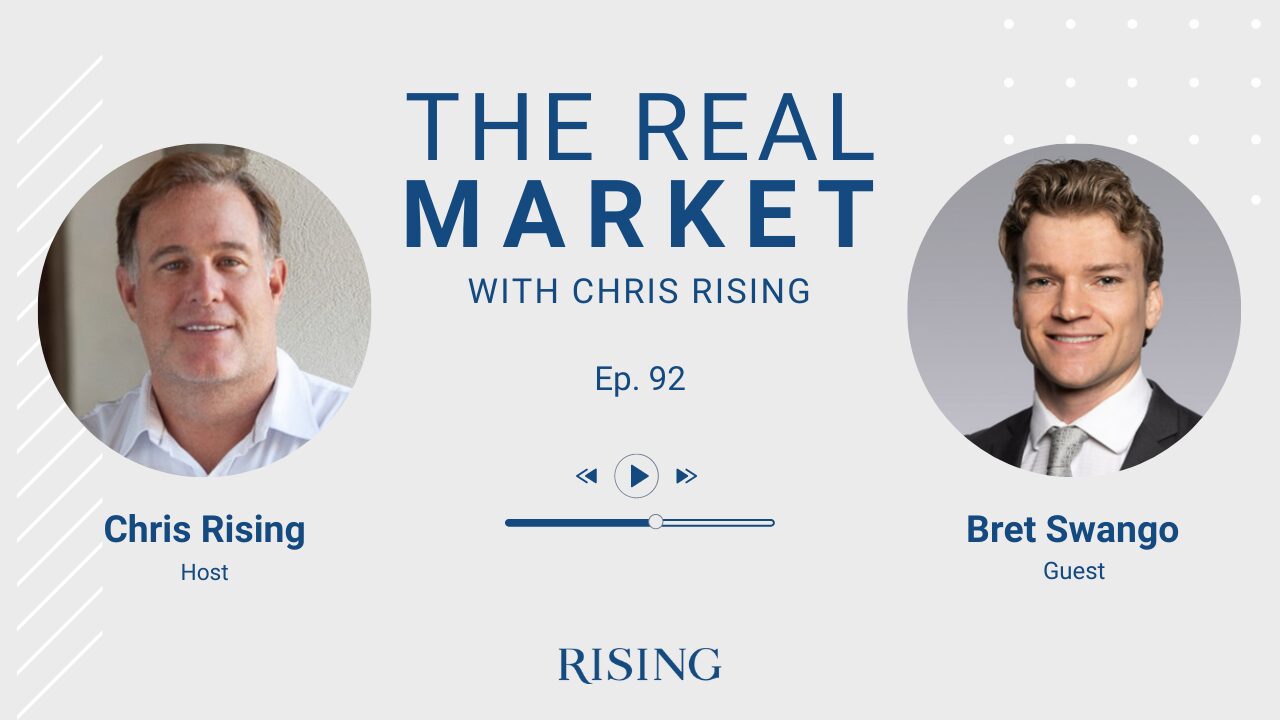
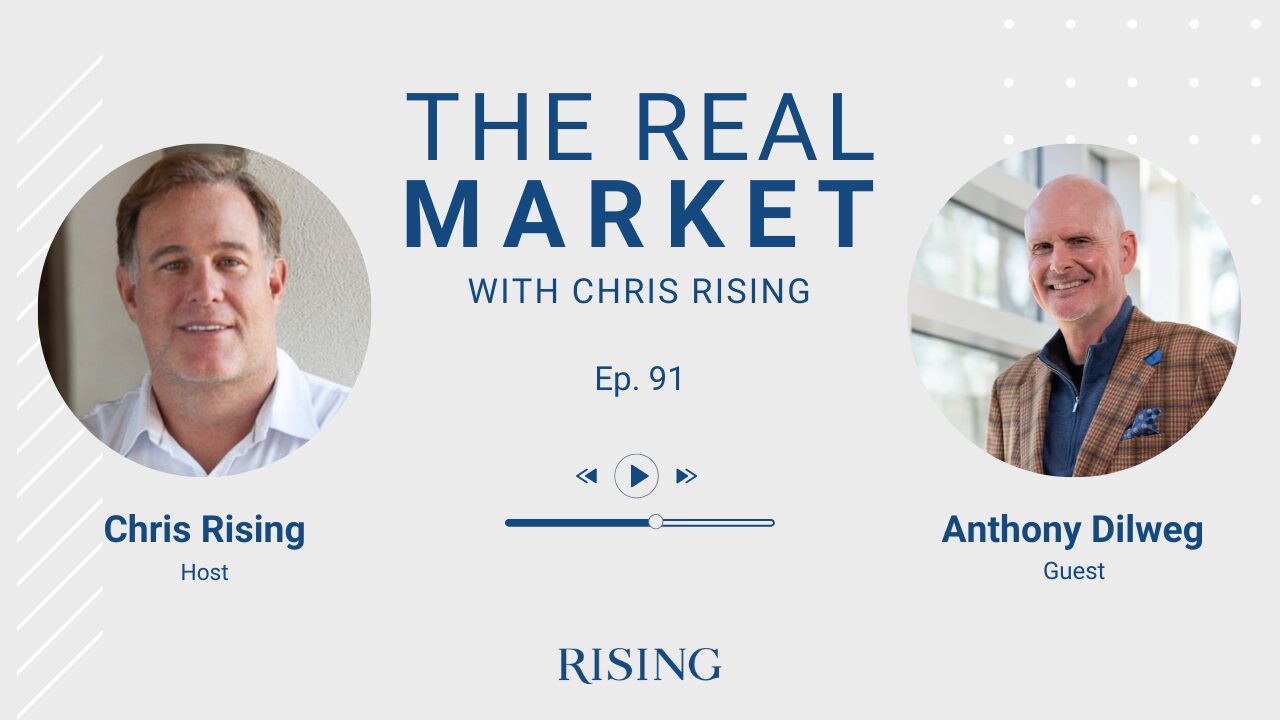
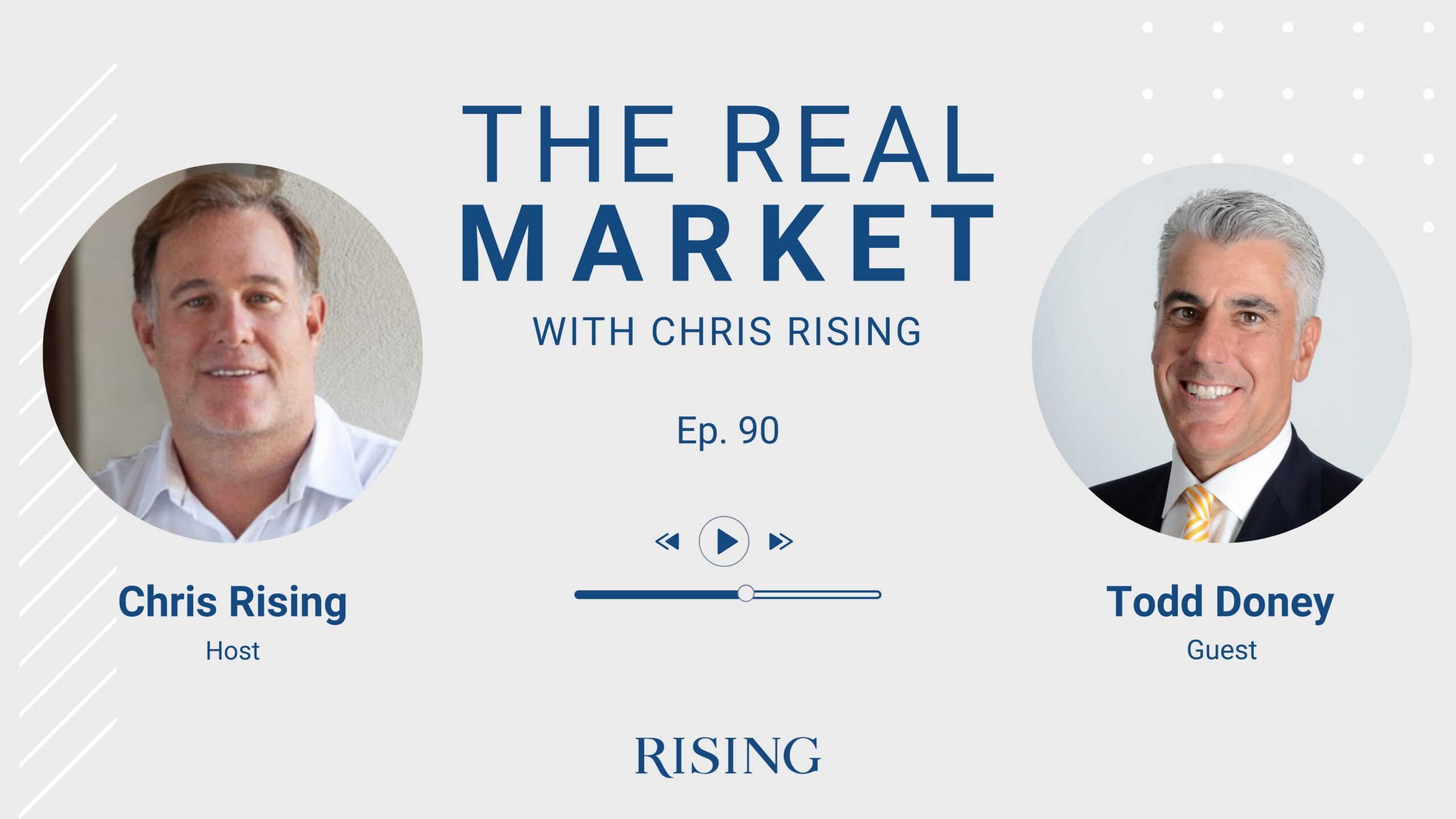


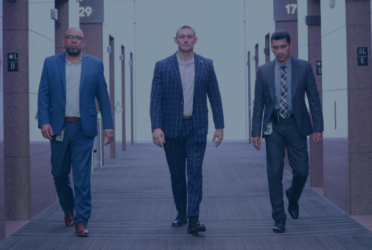
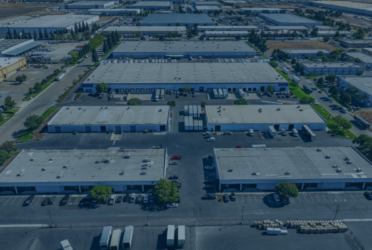
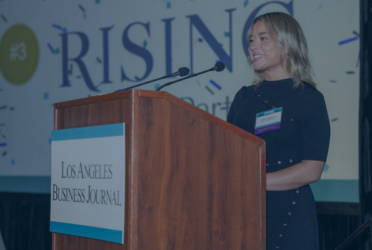
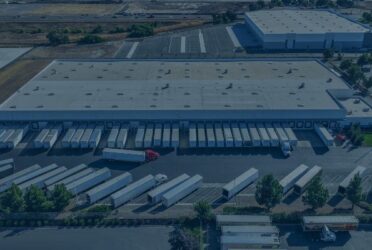
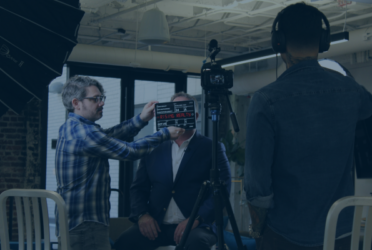
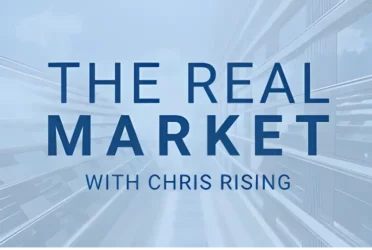 Podcast
Podcast